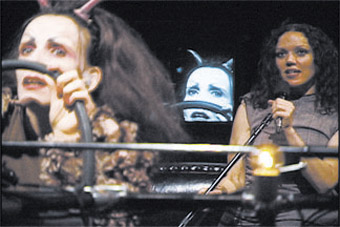Development Portfolio
My main job role within the piece was to collate the material that we came up with within the rehearsals to create a coherent script. We looked at the research that each person had managed to find on cellular memory and then going from there began trying to piece together a storyline, taking in the consideration the group we were looking at, The Wooster Group.
 |
| 'Othello' Frantic Assembly |
 |
| 'Can We Talk About This?' DV8 |
Within my research I looked at Cellular Memory within the media and programs, looking at films such as repo men and looking at one episode of The Simpsons in which they deal with a hair transplant changing someone’s personality.
Each of them focused around the negative part of cellular memory, focusing on people picking up bad traits and typically going on some sort of murder spree, or remembering something horrific.
So we decided to create something that seemingly revolved around the donor and the donor receiver but would eventually display their different stories on different levels. We decided to really try and think about how the donor receiver family would feel if he began to change. And also how the family of the donor would feel if they found out this person was taking on traits of their dead relative.
 |
| 'House/Lights' Wooster Group |
“And in the evening's master of ceremonies, the magnificent Kate Valk, we have a creature of astonishing artificiality, a tin-voiced 1930's-style beauty with marcelled hair and bee-stung lips who might be a digitally manufactured composite of movie stars. She's the ultimate screen siren, happiest in two dimensions.”
Ben Brantley (1999).
It occurred to me that within a chaotic story line, the use of a narrator might be useful to keep the audience grounded. It also occurred to me that although cellular memory is known by a lot of people there are also a lot of people who have no clue what it is.
 |
| Our Poster for 'Heartless' |
After going through these factors and considering everything that had been brought to the table we came upon the storyline that our play is at now. 'Heartless' revolves around two brothers who go through the heart transplant process. One of them starts to change slowly and throughout the piece we toy with the idea of who is dead, who is alive, who is imaginary and so on, to really keep the audience thinking. We display lots of things that could either make them discredit cellular memory or make them believe it even more.
I really wanted to look at the media and look at what role that was going to play within our piece. Some of the scenes have been written to merge with the media, and some have been written to completely feature on the media and not in the live. I kept trying to make sure that everything had a meaning but remembered that this isn’t always necessary because some of these things just happen with no proper meaning at all.
“You don’t have to worry about meaning it’s all here it’s like this space is an extension of our lives”.
Page 51 Breaking the Rules: The Wooster Group David Swan (1986)
By Joshua Williams
By Joshua Williams
BIBLIOGRAPHY
BRANTLEY, B. (1991) THEATER REVIEW; A Case For Cubism And Deals With Devils. New York Times, 3/2/1991, pg1. Available from: http://theater.nytimes.com/mem/theater/treview.html?res=980DE0DB1338F930A35751C0A96F958260 [28/12/2011].
SAVRAN, D. (1986) Breaking the Rules: The Wooster Group. (P 51)
THEOPHANES (2012) Inherited memories in organ transplant recipients, WWW. Available from: http://theophanes.hubpages.com/hub/Cellular-Memories-in-Organ-Transplant-Recipients [26/12/2012].
Watch this video called 'Transplanting Memories' at this link http://vimeo.com/10254374 for more imforation.
Watch this video called 'Transplanting Memories' at this link http://vimeo.com/10254374 for more imforation.





